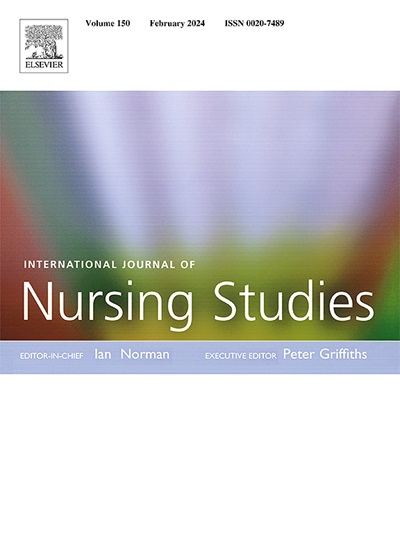麻醉教育护士在麻醉前评估中的准确性:一项诊断准确性研究
IF 7.1
1区 医学
Q1 NURSING
引用次数: 0
摘要
全球麻醉师的短缺和手术需求的增加推动了任务转移策略的采用,包括将麻醉前评估委托给注册护士。虽然在高收入国家报告了一些结果,但在中国等护士教育体系发展中的低收入和中等收入国家,关于此类做法的可行性和安全性的证据有限。目的评价国内某肿瘤专科医院接受过麻醉教育的护士麻醉前评估的准确性,以高级麻醉医师的评估结果为参考标准。次要目标包括评估美国麻醉师协会分类的一致性,并比较有和没有重症监护经验的护士麻醉前评估的准确性。方法本前瞻性横断面研究在西南地区某大城市教学医院进行。对1930例择期全麻手术患者进行24名麻醉护士和5名高级麻醉医师的麻醉前评价进行比较。计算诊断准确性指标,包括敏感性、特异性、阳性预测值和阴性预测值。使用Kappa统计评估美国麻醉医师学会分类的一致性。结果麻醉护士判断手术准备情况的总体准确率为97.7% (95% CI: 97.7% ~ 98.3%),敏感性为70.7% (95% CI: 57.3% ~ 81.9%),特异性为98.6% (95% CI: 97.9% ~ 99.0%)。阳性预测值为60.3% (95% CI, 47.7% ~ 72.0%),阴性预测值为99.1% (95% CI, 98.5% ~ 99.5%)。美国麻醉医师学会的分类是基本一致的(Kappa = 0.712)。有危重病护理经验的护士在所有准确性指标上都表现出更高的价值,尽管差异没有统计学意义。结论接受过麻醉教育的护士在执行麻醉前评估时表现出较高的总体准确性,并与资深麻醉医师有很大的一致性,这支持了他们在任务转移策略中的潜在作用。通过加强心血管评估方面的培训和支持技术的整合,可以进一步提高准确性。这些发现为在中低收入国家实施护士主导的麻醉前评估提供了有价值的证据,但需要更广泛的研究来将这些结果推广到不同的临床环境中。本文章由计算机程序翻译,如有差异,请以英文原文为准。
The accuracy of anesthesia-educated nurses in pre-anesthesia evaluation: A diagnostic accuracy study
Background
The global shortage of anesthesiologists and increasing surgical demand have driven the adoption of task-shifting strategies, including delegating pre-anesthesia evaluations to registered nurses. While some results have been reported in high-income countries, limited evidence exists regarding the feasibility and safety of such practices in low- and middle-income countries with developing nurse education systems, such as China.
Objective
To evaluate the accuracy of pre-anesthesia evaluations conducted by nurses who had undertaken education in anesthesia in a specialized cancer hospital in China, using the assessment results of senior anesthesiologists as the reference standard. Secondary objectives included assessing the agreement on the American Society of Anesthesiologists classification and comparing the accuracy of pre-anesthesia evaluations by nurses with and without critical care experience.
Methods
This prospective cross-sectional study was conducted in a metropolitan teaching hospital in Southwest China. Pre-anesthesia evaluations performed by 24 anesthesia nurses were compared to those of five senior anesthesiologists for 1930 patients undergoing elective surgery with general anesthesia. Diagnostic accuracy metrics, including sensitivity, specificity, positive predictive value, and negative predictive value, were calculated. Agreement on the American Society of Anesthesiologists classification was assessed using the Kappa statistic.
Results
Anesthesia nurses achieved an overall accuracy of 97.7 % (95 % CI: 97.0 %–98.3 %) for determining surgical readiness, with a sensitivity of 70.7 % (95 % CI: 57.3 %–81.9 %) and specificity of 98.6 % (95 % CI: 97.9 %–99.0 %). Positive and negative predictive values were 60.3 % (95 % CI, 47.7 %–72.0 %) and 99.1 % (95 % CI, 98.5 %–99.5 %), respectively. Agreement on the American Society of Anesthesiologists classification was substantial (Kappa = 0.712). Nurses with prior critical care experience demonstrated higher values in all accuracy metrics, although differences were not statistically significant.
Conclusions
Nurses with education in anesthesia demonstrated high overall accuracy and substantial agreement with senior anesthesiologists in performing pre-anesthesia evaluations, supporting their potential role in task-shifting strategies. Further improvements in accuracy may be achieved through enhanced training in cardiovascular assessment and the integration of supportive technologies. These findings provide valuable evidence for implementing nurse-led pre-anesthesia evaluations in low- and middle-income countries, but broader studies are needed to generalize these results to diverse clinical settings.
求助全文
通过发布文献求助,成功后即可免费获取论文全文。
去求助
来源期刊
CiteScore
15.00
自引率
2.50%
发文量
181
审稿时长
21 days
期刊介绍:
The International Journal of Nursing Studies (IJNS) is a highly respected journal that has been publishing original peer-reviewed articles since 1963. It provides a forum for original research and scholarship about health care delivery, organisation, management, workforce, policy, and research methods relevant to nursing, midwifery, and other health related professions. The journal aims to support evidence informed policy and practice by publishing research, systematic and other scholarly reviews, critical discussion, and commentary of the highest standard. The IJNS is indexed in major databases including PubMed, Medline, Thomson Reuters - Science Citation Index, Scopus, Thomson Reuters - Social Science Citation Index, CINAHL, and the BNI (British Nursing Index).

 求助内容:
求助内容: 应助结果提醒方式:
应助结果提醒方式:


